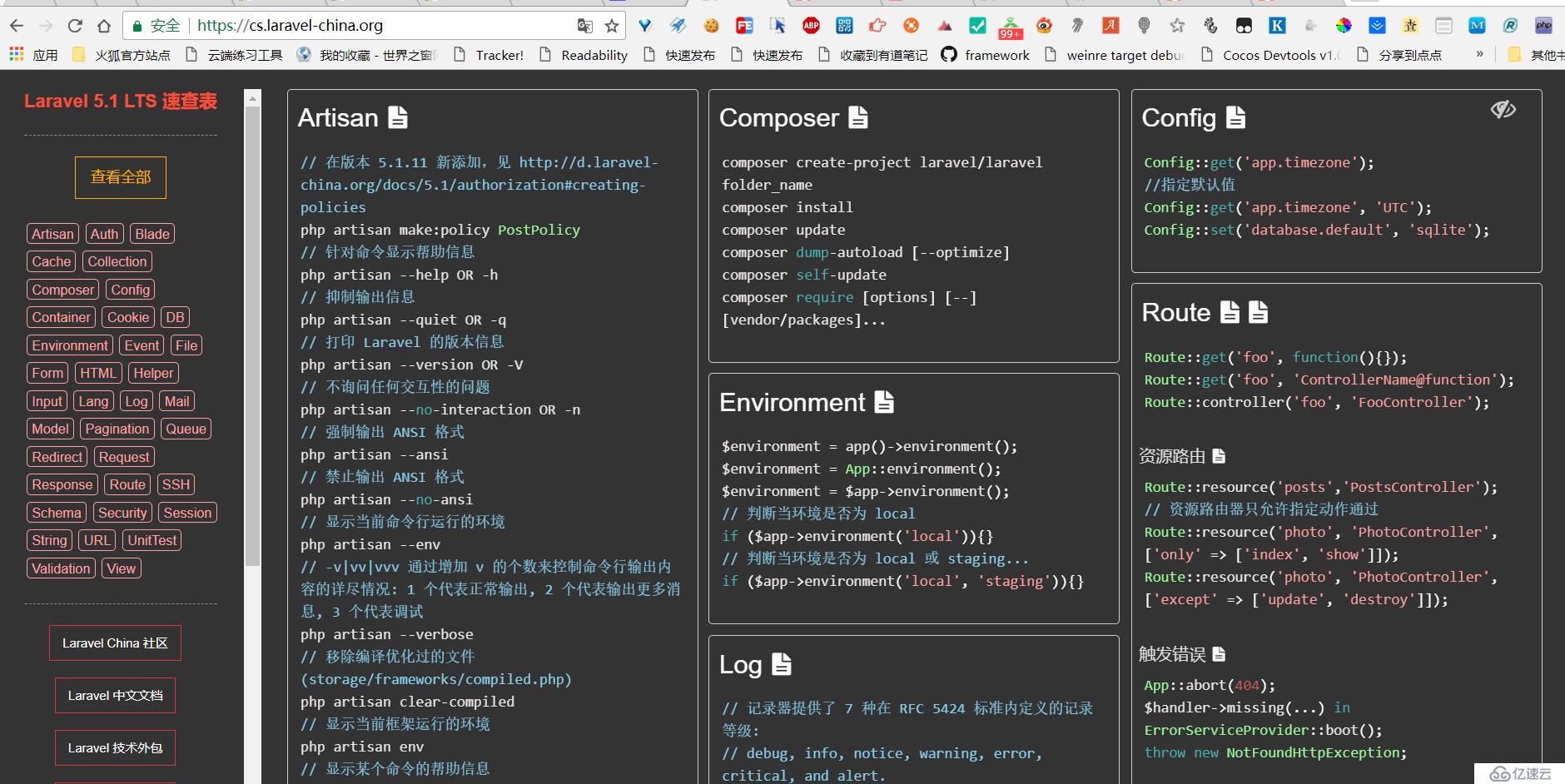我感叹于laravel的生态完好,tp5的类api的缺失(以前thinkphp3时代,帮助公司用apigen NetBeans里生成过一个3.1版本的api)。

在我走之后,估计没人用NetBeans了 所以就没人做升级。
然后我觉得laravel的速查表不错,见下图:

于是就想到了把他移植到tp5上,作为自己回到thinkphp5开发上的第一个贡献。
记得那个时候是清明前开始动手的。使用最土的,静态页面,一个个类手动去编辑。
后来发现类太多了,我每次在sublime 里 先打开一个类,复制出来临时文件,处理好,粘贴到静态index.html里,太麻烦了,要处理左侧的导航,又要定位插入的位置。 于是乎在五一放假时 我换了个思路,我不搞静态了,我搞动态的。
于是在海豚里建了一个插件,



以章节的形式添加。终于效率上去了,五一时候抽空把内容全补全了。
发布到了 掘金上,获得了17个赞。

本来以为完成了。结果老大们太积极7月4日又发布了5.0.10,然后在开发5.1dev版。
既然老大把我的速查表都挂到了tp官网上。我也不能让用的人等,看旧的5.0.7版、
可是我不想在人工去对比改了哪个类,增加还是删除了哪些方法。20多章呢。
我想 “代码的问题应该由代码解决”。于是想到了php的注解、反射类。
正好项目用到了一个 crada/php-apidoc 的api文档生成工具。
于是我就开始动手实现这通过类反射信息获取方法的工程。
PHP 5 具有完整的反射 API,添加了对类、接口、函数、方法和扩展进行反向工程的能力。 此外,反射 API 提供了方法来取出函数、类和方法中的文档注释。
官网手册提到了反射有这多类:
Reflection
ReflectionClass
ReflectionZendExtension
ReflectionExtension
ReflectionFunction
ReflectionFunctionAbstract
ReflectionMethod
ReflectionObject
ReflectionParameter
ReflectionProperty
ReflectionType
ReflectionGenerator
Reflector
ReflectionException
// TODO 获取待处理的类命名空间数据// TODO 遍历类 反射// TODO 获取类的信息 (名称、方法列表)// TODO 遍历方法列表, 获取方法的类型 和注释
我看了一遍反射是先反射类 再找到方法 再找到方法的参数
tp5的核心类 都在一个目录
于是我想到了用glob遍历
public function get_core_class(){
$class_path = CORE_PATH;
$before_cwd = getcwd();
chdir($class_path);
$names = glob('*.php');
$ret = []; foreach ($names as $key => $name) {
$ret[] = 'think\\'. str_ireplace('.php', '', $name);
}
chdir($before_cwd); return $ret;
}反射类的初始化要传的是类的实际命名空间路径。
$class= new\ReflectionClass($className); 这样。然后有以下方法:
ReflectionClass::__construct — 初始化 ReflectionClass 类
ReflectionClass::export — 导出一个类
ReflectionClass::getConstant — 获取定义过的一个常量
ReflectionClass::getConstants — 获取一组常量
ReflectionClass::getConstructor — 获取类的构造函数
ReflectionClass::getDefaultProperties — 获取默认属性
ReflectionClass::getDocComment — 获取文档注释
ReflectionClass::getEndLine — 获取最后一行的行数
ReflectionClass::getExtension — 根据已定义的类获取所在扩展的 ReflectionExtension 对象
ReflectionClass::getExtensionName — 获取定义的类所在的扩展的名称
ReflectionClass::getFileName — 获取定义类的文件名
ReflectionClass::getInterfaceNames — 获取接口(interface)名称
ReflectionClass::getInterfaces — 获取接口
ReflectionClass::getMethod — 获取一个类方法的 ReflectionMethod。
ReflectionClass::getMethods — 获取方法的数组
ReflectionClass::getModifiers — 获取类的修饰符
ReflectionClass::getName — 获取类名
ReflectionClass::getNamespaceName — 获取命名空间的名称
ReflectionClass::getParentClass — 获取父类
ReflectionClass::getProperties — 获取一组属性
ReflectionClass::getProperty — 获取类的一个属性的 ReflectionProperty
ReflectionClass::getShortName — 获取短名
ReflectionClass::getStartLine — 获取起始行号
ReflectionClass::getStaticProperties — 获取静态(static)属性
ReflectionClass::getStaticPropertyValue — 获取静态(static)属性的值
ReflectionClass::getTraitAliases — 返回 trait 别名的一个数组
ReflectionClass::getTraitNames — 返回这个类所使用 traits 的名称的数组
ReflectionClass::getTraits — 返回这个类所使用的 traits 数组
ReflectionClass::hasConstant — 检查常量是否已经定义
ReflectionClass::hasMethod — 检查方法是否已定义
ReflectionClass::hasProperty — 检查属性是否已定义
ReflectionClass::implementsInterface — 接口的实现
ReflectionClass::inNamespace — 检查是否位于命名空间中
ReflectionClass::isAbstract — 检查类是否是抽象类(abstract)
ReflectionClass::isAnonymous — 检查类是否是匿名类
ReflectionClass::isCloneable — 返回了一个类是否可复制
ReflectionClass::isFinal — 检查类是否声明为 final
ReflectionClass::isInstance — 检查类的实例
ReflectionClass::isInstantiable — 检查类是否可实例化
ReflectionClass::isInterface — 检查类是否是一个接口(interface)
ReflectionClass::isInternal — 检查类是否由扩展或核心在内部定义
ReflectionClass::isIterateable — 检查是否可迭代(iterateable)
ReflectionClass::isSubclassOf — 检查是否为一个子类
ReflectionClass::isTrait — 返回了是否为一个 trait
ReflectionClass::isUserDefined — 检查是否由用户定义的
ReflectionClass::newInstance — 从指定的参数创建一个新的类实例
ReflectionClass::newInstanceArgs — 从给出的参数创建一个新的类实例。
ReflectionClass::newInstanceWithoutConstructor — 创建一个新的类实例而不调用它的构造函数
ReflectionClass::setStaticPropertyValue — 设置静态属性的值
ReflectionClass::__toString — 返回 ReflectionClass 对象字符串的表示形式。
这些方法看着是静态,其实可以 $class->getShortName() 直接使用。
我主要需要拿到类简写名和方法。
public function generate($classNames){
config('default_return_type', 'json'); // TODO 获取待处理的类命名空间数据
// TODO 遍历类 反射
// TODO 获取类的信息 (名称、方法列表)
// TODO 遍历方法列表, 获取方法的类型 和注释
$outputs = []; foreach ($classNames as $k => $className) {
$class= new\ReflectionClass($className);
$key = $class->getShortName(); // dump($key);
$outputs[$key] = $this->getClassAnnotation($class);
} return $outputs;
}getClassAnonation 方法就是我用来获取类的全部方法的信息的方法。
拿到反射类之后 想获取反射方法,得实例化 ReflectionMethod 类。
// 获取类的注释信息
public function getClassAnnotation($class){
$ret = [ 'hasPublicMethods'=>0,
];
$ret['name'] = $class->getName();
$methods = $class->getMethods(); foreach ($methods as $key => $method) {
$class = $method->class;
$method_name = $method->name;
$rm = new \ReflectionMethod($class, $method_name); // 忽略构造和析构
if($rm->isConstructor() || $rm->isDestructor()){ continue;
}
$foo = [];
$foo['docComment'] = $rm->getDocComment();
$foo['docComment_formated'] = $this->parseMethodDoc($foo['docComment']);
$foo['args'] = $rm->getParameters();
$foo['args_formated'] = $this->parseParameters($class, $method_name, $foo['args']); if($rm->isPublic()){
$type = $rm->isStatic()? 'public_static' : 'public_public';
}else{
$type = $rm->isStatic()? 'private_static' : 'private_public';
} // 只在hasPublicMethods 为0时更新值,保证设置1后不会被复写为0
if(empty($ret['hasPublicMethods'])){
$ret['hasPublicMethods'] = stripos($type, '_public') !== false;
}
$foo['type'] = $type;
$ret['methods'][$method_name] = $foo;
} return $ret; // $className = 'think\\App';
// $class = new \ReflectionClass($className);
// config('default_return_type', 'json');
// 类名
// return $class->name;
// ReflectionClass 实例的一个字符串表示形式
// return $class->__toString();
// 同上
// return \ReflectionClass::export($className, 1);
// 获取类常量
// return json_encode($class->getConstants());
// 获取构造方法
// return $class->getConstructor();
// 类名相关
// var_dump($class->inNamespace());
// var_dump($class->getName());
// var_dump($class->getNamespaceName());
// var_dump($class->getShortName());
# 文件相关
// getFileName
// getExtensionName
// 属性相关
// return $class->getDefaultProperties();
// return $class->getProperties(\ReflectionProperty::IS_PUBLIC | \ReflectionProperty::IS_PROTECTED);
// const integer IS_STATIC = 1 ;
// const integer IS_PUBLIC = 256 ;
// const integer IS_PROTECTED = 512 ;
// const integer IS_PRIVATE = 1024 ;
// return $class->getStaticProperties();
// 类注释
// return $class->getDocComment();
}先获取全部的类方法:
$class->getMethods();
官网的例子:
array(3) {
[0]=>
&object(ReflectionMethod)#2 (2) {
["name"]=> string(11) "firstMethod"
["class"]=> string(5) "Apple"
}
[1]=>
&object(ReflectionMethod)#3 (2) {
["name"]=> string(12) "secondMethod"
["class"]=> string(5) "Apple"
}
[2]=>
&object(ReflectionMethod)#4 (2) {
["name"]=> string(11) "thirdMethod"
["class"]=> string(5) "Apple"
}
}在获取时还可以传属性类型进行过滤:
<?phpclass Apple { public function firstMethod() { } final protected function secondMethod() { } private static function thirdMethod() { }
}
$class = new ReflectionClass('Apple');
$methods = $class->getMethods(ReflectionMethod::IS_STATIC | ReflectionMethod::IS_FINAL);
var_dump($methods);?>拿到方法后,我们需要获得类的方法的公有私有、静态等属性。

因为我在显示时做了方法不同类型的区分演示。
$rm = new \ReflectionMethod($class, $method_name);// 忽略构造和析构if($rm->isConstructor() || $rm->isDestructor()){ continue;
}先过滤掉构造和析构方法。
$foo = [];$foo['docComment'] = $rm->getDocComment();$foo['docComment_formated'] = $this->parseMethodDoc($foo['docComment']);$foo['args'] = $rm->getParameters();$foo['args_formated'] = $this->parseParameters($class, $method_name, $foo['args']);
我先获取了原有方法的文档信息和参数信息,并且按照我需要的进行格式化。
获取参数的要注意,返回的是参数数组
官方示例:
<?phppublic static function fire_theme_method($class, $method){
$fire_args=array();
$reflection = new ReflectionMethod($class, $method); foreach($reflection->getParameters() AS $arg)
{ if($_REQUEST[$arg->name])
$fire_args[$arg->name]=$_REQUEST[$arg->name]; else
$fire_args[$arg->name]=null;
}
return call_user_func_array(array($class, $method), $fire_args);
}?>主要咱获取到参数名称 然后结合methodName 去实例化 ReflectionParameter 来获取参数信息
public function parseParameters($class, $method, $args){ if($args){
$args_str = []; foreach ($args as $key => $arg) {
$p = new \ReflectionParameter(array($class, $method), $key); // 判断是否引用参数
if($p->isPassedByReference()){
$arg_str_new = "&\$".$p->getName();
}else{
$arg_str_new = "\$".$p->getName();
} if ($p->isOptional() && $p->isDefaultValueAvailable()) {
$a_clsss = $class; // 获取某些内部类的参数会抛异常,且异常时$class会变化不是我们想知道的哪个类方法一场了
try{
$defaul = $p->getDefaultValue();
$arg_str_new .= is_array($defaul) ? ' = '. '[]': ' = '. var_export($defaul, 1);
}catch(\Exception $e){
trace($p->isVariadic());
trace($a_clsss.'/'.$method.'_'.$key);
}
}
$args_str[] = $arg_str_new;
} return implode(', ', $args_str);
} return '';
}有的方法没参数直接返回空,有的有参数,咱们想拼接处 参数字符串 比如
<?phpclass A{ function foo($a){
}
}php不会返回foo($a)这串的。得自己处理
主要留意参数的 是否有默认值、是否引用
getName
isOptional
isDefaultValueAvailable
getDefaultValue
在获取默认值参数的时候 我发现有的时候会抛异常,而且都报的是内部类的。
所以一定要try catch 去获取默认值。
至此 整个获取某些类的 方法及方法注释和参数信息 的功能全部实现。
大家如果想获取某一组class的 速查表 只需 修改get_core_class返回值,只要是tp5里自动加载的类。都可以解析。
整体思路,根据类数组获取方法->方法文档、获取参数->获取参数信息
这样,我就可以安心的偷懒了。下次tp升级,我直接composer update一下,刷新一下首页,拿到静态html 更新到我的 gh-pages 分支。就完成了新框架速写表的更新。
一劳永逸啊。
具体源码参考 :https://github.com/yangweijie/thinkphp-lts
查看速查表 直接:https://yangweijie.github.io/thinkphp-lts/

欢迎给我提供建议。
免责声明:本站发布的内容(图片、视频和文字)以原创、转载和分享为主,文章观点不代表本网站立场,如果涉及侵权请联系站长邮箱:is@yisu.com进行举报,并提供相关证据,一经查实,将立刻删除涉嫌侵权内容。